Philippines Overstrikes and Countermarks: Concerning Mexican Coins
by Kyle Ponterio
The enormous variety of host coin and countermark combinations that occur in the Spanish colony of the Philippines during 1828-37 created a series that is never ending and impossible to complete. After identifying over 1,600 specimens by inspecting individual examples and acquiring images from various sources including auction catalogs, books, private collections, institutions, pamphlets, periodicals etc. one can explain the whole Philippines countermark series using almost all Mexican host coins as examples. There are three exceptions, one at the very beginning and two towards the end where Mexican host coins for particular varieties were not known to the author. As such, substitutes were used to fill the gaps to give the reader a clearer understanding.
In general, Mexican host coins are some of the most common to be found in the countermark series of the Philippines, but it also includes some of the rarest. There are three major types from this series the Manila overstrikes 1828 & 1830, Ferdinand VII (F.7.0) (1832-34) and Isabella II (Y.II.) (1834-37) as well as categories for minor coinage, gold, additional countermarks, corrected and perforated (holed) examples. The Manila dies were all prepared locally by foundry master Benito de los Reyes at the same foundry where the cast copper brillias were produced. When they switched to the hand held punches of F.7.0 and Y.II. the local government hired Diego de los Reyes to prepare them. The areas of Mexican numismatics covered here include Pillars, Portraits, War of Independence, Empire of Iturbide and early Republic issues up to 1836. Even though Mexican hosts are plentiful if one is patient one can acquire real rarities in their own right.
After the colonies of the Americas gained independence and started issuing their own coinage, the Philippines, one of Spain’s last hold outs, began to see a large influx of coinage with legends that the crown found offensive. Fearing that these offensive insurgent issues might incite an uprising the local government at Manila decided to take action.
The “Manila” overstrikes
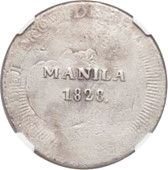
On 13 October 1828, Mariano Ricafort, Captain General of the Philippine Islands, a subdivision of the Vice-Royalty of Mexico, issued an edict introducing a system of marking the “Pesos y Onzas de oro” produced by the “Provincias insurectas y gobiernos revolucionarios” of the South American continent so that such subversive words as “Republica”, “Indepencia”, and“Libre” commonly seen on the newly issued coinage would be obliterated. Thus we have the 1828 and 1830 Manila overstrike issues, each of which had two sets of dies prepared. These were manufactured in a similar fashion to the 960 Reis of Brazil as the authorities completely overstruck the host coins trying to obliterate any and all signs of the original design. Producing these issues ultimately proved to be costly and inefficient with large gaps between production runs.
The traditional thought process for the issues dated 1828 is that there are two different types. The first have full design features such as the serrated border to obscure the offensive legends of both obverse and reverse, full legends “HABIITADO POR EL REY N.S.D.FERN.VII.” (Rehabilitated by the King our Lord Don Fernando VII) around the crowned arms of Spain (obverse) and Manila above date “1828” (reverse). The second type was supposedly caused by effacing the dies by removing the serrated borders and legend leaving only the central design features. Again this was supposedly done due to the frequent break downs, so that the design was easier to impress upon the host.
Though I do not believe this to be the case I do believe them to be related. As the minting equipment kept breaking down the pressure required to fully impress the design features on the hosts became less and less, causing weaker and weaker strikes. The lack of details seemed to coincide with this logic. However, every example that I have examined had remnants of the supposedly effaced details. This leads us to believe that there is in fact only one type.
We know that Benito de los Reyes prepared two sets of dies for the 1828 issues. I have identified them as Die # 1 and Die # 2. These arbitrary designations are for identification purposes as there is no documented evidence which supports this; as such the order is purely conjecture. It is the thought of the author based on the style of these two pairs of dies that Die # 1 was used first and Die # 2 was used second as it is closer in style to that of the 1830 issues. During my research I have been able to identify over 158 individual examples between the two different sets of dies, 30 of which are Mexican host coins all struck with Die # 1. It is possible that muleing of these dies exists. However, no such specimen is known to the author that would indicate this.
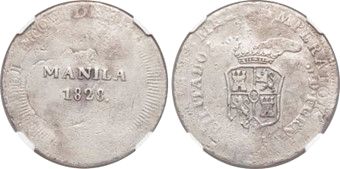 Manila 1828 Die # 1, host Mexico Empire of Iturbide 8 Reales 1822. Only a couple are known to be hosts for the overstrikes.
Manila 1828 Die # 1, host Mexico Empire of Iturbide 8 Reales 1822. Only a couple are known to be hosts for the overstrikes.
(Heritage CICF 2014 auction, lot 25625)
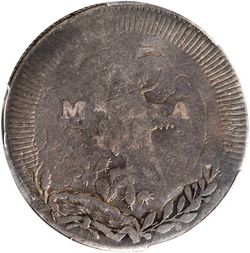
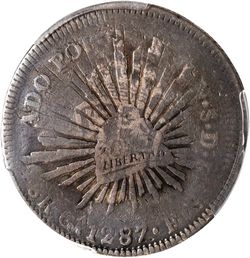
Manila 1828 Die # 1, host Mexico Republic 8 Reales 1287(1827)-GaFS. One of only four examples known and specifically mentioned in Resplandores.
(Stack’s Bowers and Ponterio NYINC auction, 9 Jan. 2015, “The Ray Czahor Collection”, lot 1360)
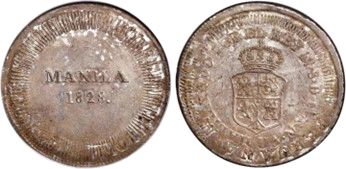 Manila 1828 Die # 2, host Peru 8 Reales 1828-LM JM. Common host coin in unusually high quality. Normally found in Fine to Very Fine condition with weak or uneven strikes, pieces found above Very Fine and with a full strike of both obverse and reverse dies are indeed very rare.
Manila 1828 Die # 2, host Peru 8 Reales 1828-LM JM. Common host coin in unusually high quality. Normally found in Fine to Very Fine condition with weak or uneven strikes, pieces found above Very Fine and with a full strike of both obverse and reverse dies are indeed very rare.
(Heritage ANA 2015 auction Lot # 32328)

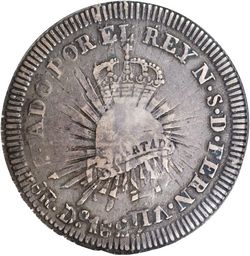
Manila 1830, host Mexico Republic 8 Reales 1827-DoRL. (Stack’s Bowers & Ponterio NYINC 2014 auction, lot 1530, Ex Heritage CICF 2013 auction Lot # 25239, Ex Lyn Knight 10 June 2012 Lot # 5341 “The Dr. Greg Pineda Collection”, Ex Ponterio & Associates Auction # 68 CICF 14-15 April 1994 Lot # 1467, Ex Ponterio & Associates Auction # 58 17 Oct. 1992 Lot # 1492, Ex Aureo Auction 23 Oct. 1990 Lot # 937, Ex Schulman 18-19 March 1966 Lot # 1122 “The Howard D. Gibbs collection”)
The 1830 overstrikes are nearly identical to those of 1828 except for the date, a few minor differences and that different minting equipment was used in their manufacture. The frequent breakdowns of the 1828 issues eventually required the replacement of the equipment. So a new press was ordered from Bengal. When it arrived it was discovered that the old dies could not be retro-fitted and that new dies were required. Two sets of dies were prepared, but commencement of the overstriking did not begin until the issuance of the 16 January 1832 decree. About a week into production the new Bengal press broke down.
It is interesting to note that every example studied was struck with only one set of dies. Though this is not unusual in and of itself it is peculiar as it is known that two sets of dies were produced by Benito de los Reyes who also produced both sets of dies for the 1828 issues, but which used different minting equipment. This could be due to the minting equipment continuously breaking down to the point where it could no longer be repaired and used, thus not placing the second set of dies into production. It is believed that there are approximately 20-30 examples known of which I have been able to locate 13, with only four being Mexican hosts. The 1830 overstrikes are considered one of the keys to the series and as such very rare.
Ferdinand VII hand held punches “F.7.0”
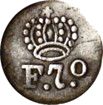 When the authorities eventually abandoned the overstriking process they switched to the hand held punches produced by Diego de los Reyes containing the King’s cipher “F.7.0”. These new punches were more compact and could be applied with a hammer, supposedly to the obverse of the insurgent coins, foreign coins and badly worn or mutilated coins. These countermarks were applied for just overtwo years, authorized on 2 October 1832, commenced on 5 October 1832 and officially ending on 20 December 1834.
When the authorities eventually abandoned the overstriking process they switched to the hand held punches produced by Diego de los Reyes containing the King’s cipher “F.7.0”. These new punches were more compact and could be applied with a hammer, supposedly to the obverse of the insurgent coins, foreign coins and badly worn or mutilated coins. These countermarks were applied for just overtwo years, authorized on 2 October 1832, commenced on 5 October 1832 and officially ending on 20 December 1834.
With the implementation of these new hand held punches we see a greater variety of host coins, including minor coinage such as 1, 2, and 4 Reales. Smaller denominations from this series are all rare with the 2 Reales being the most “common” and the 1 Real being the rarest. Over 436 examples of various 8 Reales have been cited, with 134 on Mexican host coins. There are three major pearl sequence patterns; 5-4-*(1), 5-4-1 and 5-4-!(2) each with multiple punches.

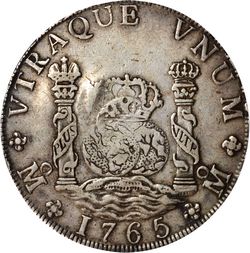
F.7.0 with 5-4-! pearl sequence, host Mexico Pillar 8 Reales 1765-MF; Note: Anvil damage on reverse displaying a mirror image of countermark.
(Stack’s Bowers and Ponterio NYINC auction 9 January 2015 “The Ray Czahor collection”, lot 1373, Ex Philippine Numismatic & Antiquarian Society 19th Annual Convention and Grand Auction 14-15 Nov. 1992 Lot # 350 (Front cover coin))
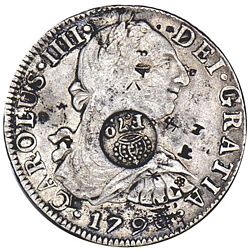
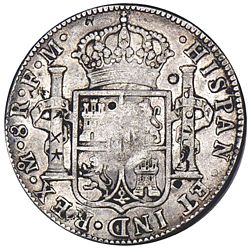
F.7.0 with 5-4-1 pearl sequence, host Mexico Bust 8 Reales 1790-FM, transitional Bust of Charles III, but in the name of Charles IV (ordinal IIII). This one is quite interesting as it displays three generations of Habsburgs.
(Stack’s Coin Galleries 17 Dec. 2008 , lot 1228)
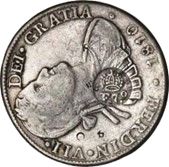
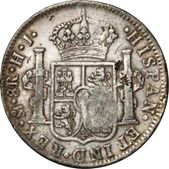
F.7.0 with 5-4-! pearl sequence, host Mexico Bust 8 Reales 1810-HJ. Quite a pleasant example with minimal chopmarks and fairly high grade.(Private collection)
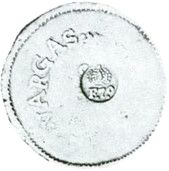
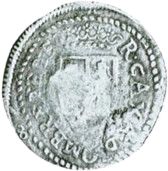
F.7.0 with 5-4-1 pearl sequence, host Mexico War of Independence 8 Reales 1812 Somberete de Vargas. Extremely rare host coin with very few examples known for all types. Plated in Lopez-Chavez-Yriarte, Type III Group B # 1580.
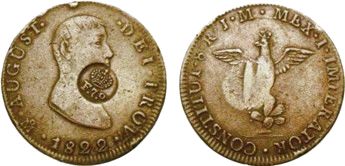 F.7.0 with 5-4-1 pearl sequence, host Mexico Empire of Iturbide 8 Reales 1822-JM, First bust type with skinny eagle; the phallic like anvil damage on the reverse consistently shows up throughout the series in various locations. (Ponterio & Associates Auction # 142 27-28 April 2007 Lot # 2521)
F.7.0 with 5-4-1 pearl sequence, host Mexico Empire of Iturbide 8 Reales 1822-JM, First bust type with skinny eagle; the phallic like anvil damage on the reverse consistently shows up throughout the series in various locations. (Ponterio & Associates Auction # 142 27-28 April 2007 Lot # 2521)
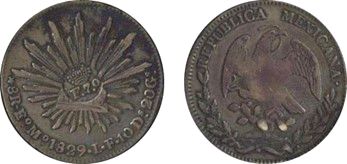 F.7.0 with 5-4-1 pearl sequence. Host Mexico Republic 8 Reales 1829-EoMo. Rare host coin in its own right.
F.7.0 with 5-4-1 pearl sequence. Host Mexico Republic 8 Reales 1829-EoMo. Rare host coin in its own right.
(From the Mariano M. Cacho Jr. collection # VIII- CS-040, Ex Bank Leu Auction 24 Oct. 1990 “A Bostonian Collection”)
Isabella II hand held punches Y.II.
 Upon the death of her father, Ferdinand VII, Isabella II became Queen and we see yet another change in the countermarks of the Philippines. No longer do they contain the King’s cipher “F.7.0”, but instead the cipher of the new Queen “Y.II.” (decree of 20 December 1834, suppressed 31 March 1837 (by decree of 1 February 1836)). As with the previous “F.7.0” countermark, all minor coinage bearing the “Y.II” countermark are rare. Over 832 various 8 Reales have been cited with more than 335 being on Mexican host coins. There are seven major pearl sequence patterns; 5-2-2, 5-3-1, 5-3-2, 5-3-3, 5-4-1, 5-4-2 and 5-4-3, many with multiple punches.
Upon the death of her father, Ferdinand VII, Isabella II became Queen and we see yet another change in the countermarks of the Philippines. No longer do they contain the King’s cipher “F.7.0”, but instead the cipher of the new Queen “Y.II.” (decree of 20 December 1834, suppressed 31 March 1837 (by decree of 1 February 1836)). As with the previous “F.7.0” countermark, all minor coinage bearing the “Y.II” countermark are rare. Over 832 various 8 Reales have been cited with more than 335 being on Mexican host coins. There are seven major pearl sequence patterns; 5-2-2, 5-3-1, 5-3-2, 5-3-3, 5-4-1, 5-4-2 and 5-4-3, many with multiple punches.
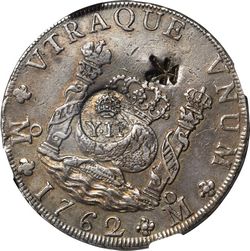
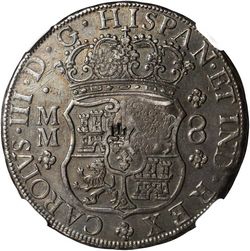
Y.II. with 5-2-2 pearl sequence, host Mexico Pillar 8 Reales 1762/1-MM. A high grade example with minimal chopmarks. (Stack’s Bowers and Ponterio NYINC auction 9 January 2015, “The Ray Czahor collection”, lot 1402, Ex Paul Bosco Auction # 18 4 Aug. 1997 Lot # 229 “The Hal Walls Collection of World Trade Coins”)
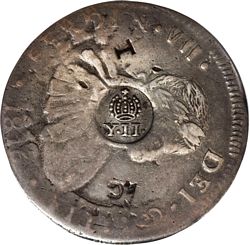
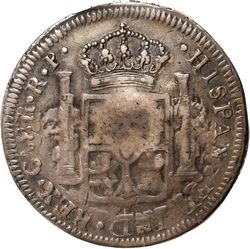
Y.II. with 5-4-3 pearl sequence, host Mexico War of Independence 8 Reales 1816-CaRP. Scarce host with an excellent early provenance.
(Stack’s Bowers and Ponterio NYINC auction 9 January 2015 “The Ray Czahor collection”, lot 1404, Ex Schulman 19-21 March 1968 Lot # 639 , Medina Plate Coin)
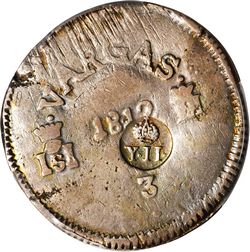
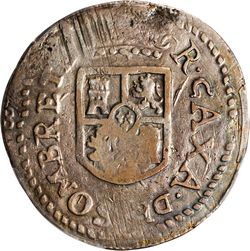
Y.II. with 5-3-2 pearl sequence, host Mexico War of Independence 8 Reales 1812 Somberete de Vargas. Another example of this extremely rare host coin.
(Stack’s Bowers & Ponterio NYINC auction 9 Jan. 2015 Lot # 1407 “The Ray Czahor Collection”, Ex World Wide Coin of California Auction XXX 14 Nov. 1996 Lot # 323)
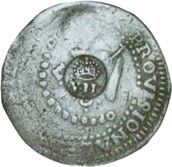 Y.II. with 5-4-1 pearl sequence, host Mexico War of Independence 8 Reales 1811 Moneda Provisional L.V.O., one of only two known to the author with the other housed in the American Numismatic Association’s collection. (Ponterio & Associates auction # 14 25 April 1984 Lot # 330)
Y.II. with 5-4-1 pearl sequence, host Mexico War of Independence 8 Reales 1811 Moneda Provisional L.V.O., one of only two known to the author with the other housed in the American Numismatic Association’s collection. (Ponterio & Associates auction # 14 25 April 1984 Lot # 330)
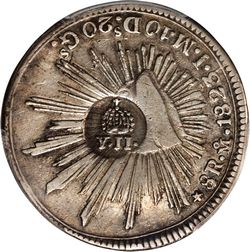
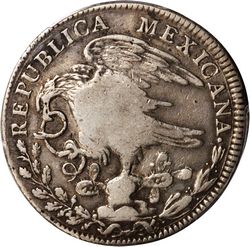
Y.II. with 5-4-3 pearl sequence, host Mexico Republic “Hookneck” 8 Reales 1823-MoJM, Flat top 3 with curled snake. Scarce and popular type.
(Stack’s Bowers and Ponterio NYINC auction 9 Jan. 2015 Lot # 1416 “The Ray Czahor collection”)
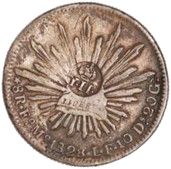
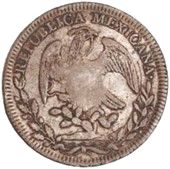
Y.II. with 5-3-2 pearl sequence, host Mexico Republic 8 Reales 1828-EoMoLF. Very rare host with an excellent provenance.
(American Numismatic Society collection # 1926.999.129)
Minor Coinage
Before the below stated decree minor coinage was to circulate freely without being countermarked. So any “F.7.0” countermarks found on minors is either the result of random pieces mixed in with the submitted coins to be revalidated or someone messing around at the countermarking office because the date of the decree (14 December 1835, suppressed 31 March 1837 (by decree of 1 February 1836)) is after the “Y.II.” countermarks were put into use. For the 1 Real all 11 pieces cited are from Mexico, for the 2 Reales of the 44 pieces cited 35 are Mexican hosts and for the 4 Reales of the 18 pieces cited 12 are on Mexican hosts.


Y.II. with 5-4-3 pearl sequence, host Mexico Republic 1 Real 1830-GoMJ. (private collection)
Y.II. with 5-2-2 pearl sequence, host Mexico Pillar 2 Reales 1756-M. Extremely rare host type for a minor issue.
(Baldwin’s Hong Kong Auction # 50 7 April 2011 Lot # 1155.)
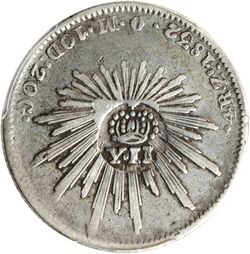
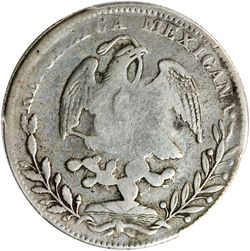
Y.II. with 5-4-1 pearl sequence, host Mexico Republic 4 Reales 1832-ZsOM.
(Stack’s Bowers and Ponterio NYINC auction 9 Jan. 2015 Lot # 1391 “The Ray Czahor collection”.)
Gold
Of all of the issues in this series, gold coins are certainly some of the rarest. The most commonly seen is the 8 Escudos; all other denomination are exceedingly rare and virtually uncollectable, with less than a handful known. I have 20 different pieces cited with only four on Mexican host coins, all 8 Escudos. One is an “F.7.0” and the other three are “Y.II.”, including an Iturbide 8 Escudos.
Y.II. with 5-4-3 pearl sequence, host Mexico Empire of Iturbide 8 Escudos 1822-JM.
(Glendinings 16 Oct. 1989 Lot # 312 “The John J. Ford collection”)
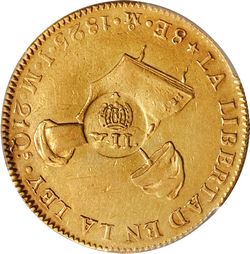
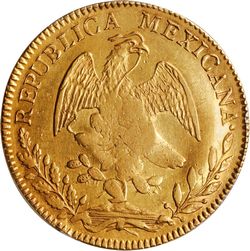
Y.II. with 5-4-3 pearl sequence, host Mexico Republic “Hand on book” 8 Escudos 1825-MoJM.
(Stack’s Bowers and Ponterio NYINC auction 9 Jan. 2015 Lot # 1428 “The Ray Czahor collection”.)
Additional countermarks
All additional countermarks should be considered very rare. The most common is the Peru 1824 Royalist crown countermark with about 12 pieces cited whilst all others are extremely rare to unique. I have 19 pieces cited with only three on Mexican host coins.
F.7.0. with 5-4-1 pearl sequence over previous Manila overstrike, host Mexico Republic with illegible date or mintmark. From the Mariano M. Cacho Jr. collection # IV- CS-001, Ex Philippine Numismatic Monographs Number 16 August, 1966, Ex The Numismatist Vol. LX Apr 1947(Reprint) Fig. 3, Ex Pablo I. de Jesus collection.
Y.II. with 5-4-1 pearl sequence over previous F.7.0 with 5-4-! pearl sequence, host Mexico Republic 8 Reales 1833-ZsOM. Plated in Philippine Numismatic Monographs Number 21 November 1981 # IX-12.
Corrected coins
The original decree stated that the countermarks were to be applied to the obverse of the offending coins. However, with some of the coins the countermarking office found it difficult to determine which side was the obverse and which was the reverse. In some instances the countermarks were applied to the reverse first, then immediately flipped over and struck again thus correcting the mistake made. I have 11 pieces cited with six on Mexican host coins.
Y.II. with 5-4-3 pearl sequence, host Mexico War of Independence 8 Reales 1820-CaRP. Notice the flattening of the reverse countermark caused by the application of the obverse countermark.
(Stack’s Bowers and Ponterio NYINC auction 11 Jan. 2013 Lot # 1625, Ex Almanzar’s Mail Bid Auction 8 March 1982 Lot # 1270)
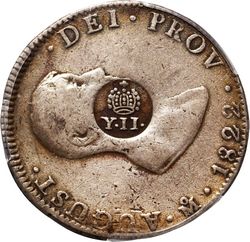
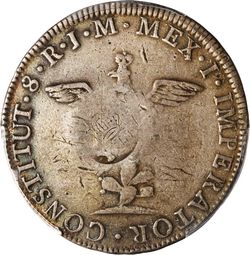
Y.II. with 5-4-3 pearl sequence, host Mexico Empire of Iturbide 8 Reales 1822-Mo JM, Iturbide First Bust Type with Skinny eagle.
(Stack’s Bowers and Ponterio NYINC auction 9 Jan. 2015 Lot # 1411 “The Ray Czahor collection”)
Perforated coins
The perforated examples are integral to the series as several of the punches can be linked back to early collections prior to the discovery of forgeries in the 1930s. Several of these examples are housed in the American Numismatic Society’s collection and one plated in José T. Medina’s early work Las Monedas Obsidionales Hispano-Americanas, published in Santiago, Chile in 1919.
On 27 August 1834 a decree was issued stating that pierced coins were no long acceptable legal tender. This of course did not sit well with the local populace and nearly caused an uprising. Due to the fact of disgruntled locals the government at Manila issued the 4 September 1834 decree where holed coins with countermarks over both sides would again become legal tender. Interesting to note about this special issue is that fact that when the countermarks were applied to both sides they were done so at the exact same time. If they were applied in succession one of the opposing sides would show signs of flattening much like the corrected examples above. Also, noted is that the punches though usually rotated to one degree or another are also in alignment with each other. This suggests that one or both punches were affixed somehow either as a hammer and anvil die or like a pair of pliers similar to the Guatemala Type IV countermarks issued in late 1840 to early 1841. The aforementioned decree states that the holed or pierced coins would be accepted as legal tender as long as countermarks were applied over both sides of the hole. Now with that being said not every example has countermarks over both sides of the hole. The pieces with only one countermark are on the obverse in accordance to the original decree of 2 October 1832 where all countermarks were to be applied to the obverse of the hosts. Coins with countermarks over both sides of the perforation are very rare. Coins with countermarks on only one side of the perforation, on minor coinage or with previous countermarks with perforations are extremely rare.
The first and fourth images below are two colonial bust 8 Reales that were used as substitutes as I was unable to locate an example of the type on a Mexican host. Usually when one thinks of coins with holes in them it is considered damage since for the most part the holes are the result of piercing after the coins left the mint. In some instances in the cut and countermarked series plugs were officially removed by a government entity for assaying and/or inflation (lower intrinsic value with nominal face value). There are instances where plugs were unofficially removed by unscrupulous individuals trying to make a little extra on the side. In both instances this was done for a very specific reason. However, with the perforated (holed) coins of the Philippines what makes them special by comparison is the fact the holes were authorized after the fact by the aforementioned decree. I have 70 pieces cited with only 11 on Mexican hosts.
Y.II. with 5-3-2 pearl sequence applied to obverse of perforation, host Peru bust 8 Reales 1819- LIMA JP. Excellent early provenance with clear details of the countermark.
(American Numismatic Society collection # 1933.999.725)
Y.II. applied to both sides of perforation, host Mexico bust 8 Reales1786-FM. (private collection.)
Y.II. applied to both sides of perforation with previous Y.II. on obverse, host Peru bust 8 Reales 1819-LIMA JP.
(Spink Auction # 5014 Lot # 941, Ex The Money Company Auction 25 Jan. 1982 Lot # 578, Ex Superior auction 4-8 June 1979 Lot # 2477).
Y.II. applied to both sides of both perforations, host Mexico War of Independence 8 Reales 18xx-ZsAG; Note: both obverse and both reverse countermarks are the same and have the same alignment and rotation. This piece is one of the keys to understanding the perforated examples as it shows that the punches were in fact affixed in some manner.
(American Numismatic Society collection # 1927.999.238)
The countermark series of the Philippines has many nuances with many myths and wives’ tales. No doubt there are a plethora of forgeries made to fool collectors. However, many examples which surfaced in mid part of the last century have been wrongly condemned today. Not because they are forgeries, but because of the time when they came to market. Prior to their appearance in the marketplace many of the extremely common examples such as Peru standing liberty types and Mexican “Cap & Ray” types were not worth enough to be photographed in early auction catalogs or even to be offered as a single coin in an auction or pricelist. Some of the countermarks on those examples are viewed as spurious, but can be linked back to the early part of the 20th century prior to the discovery of forgeries either through punch linking or plated examples. When looking at this series as a whole it can be quite overwhelming with the various combinations of hosts and countermarks. If one takes a step back to look at the bigger picture it is not all that complicated, but it is very sophisticated.
